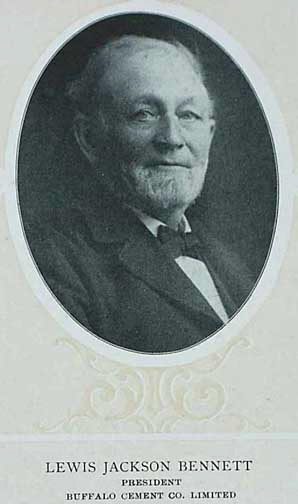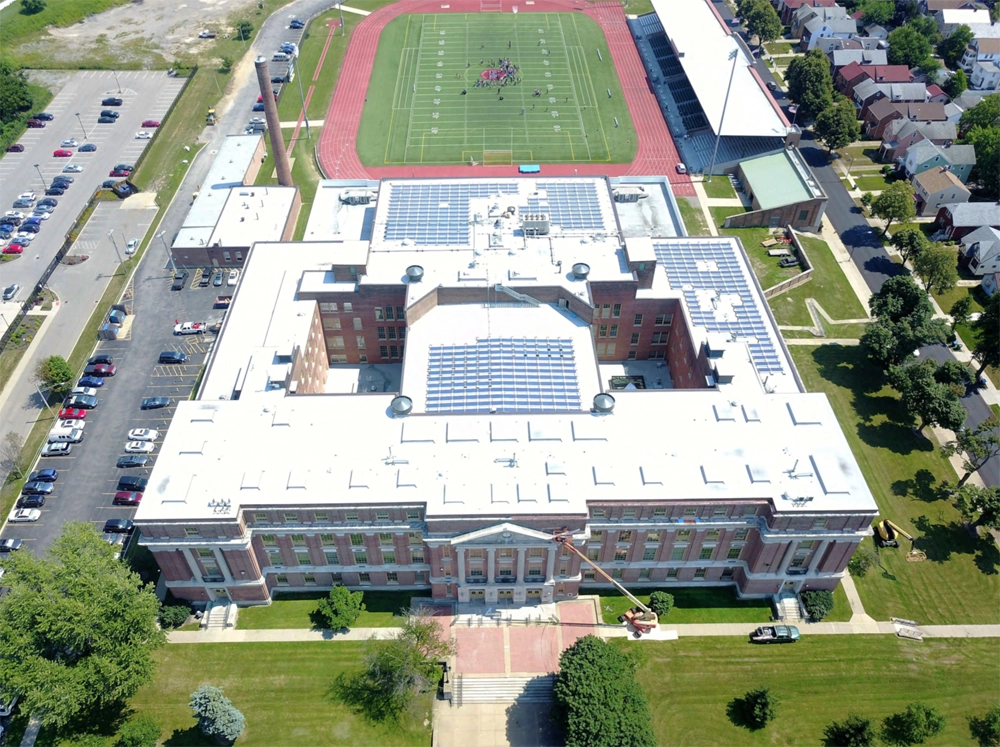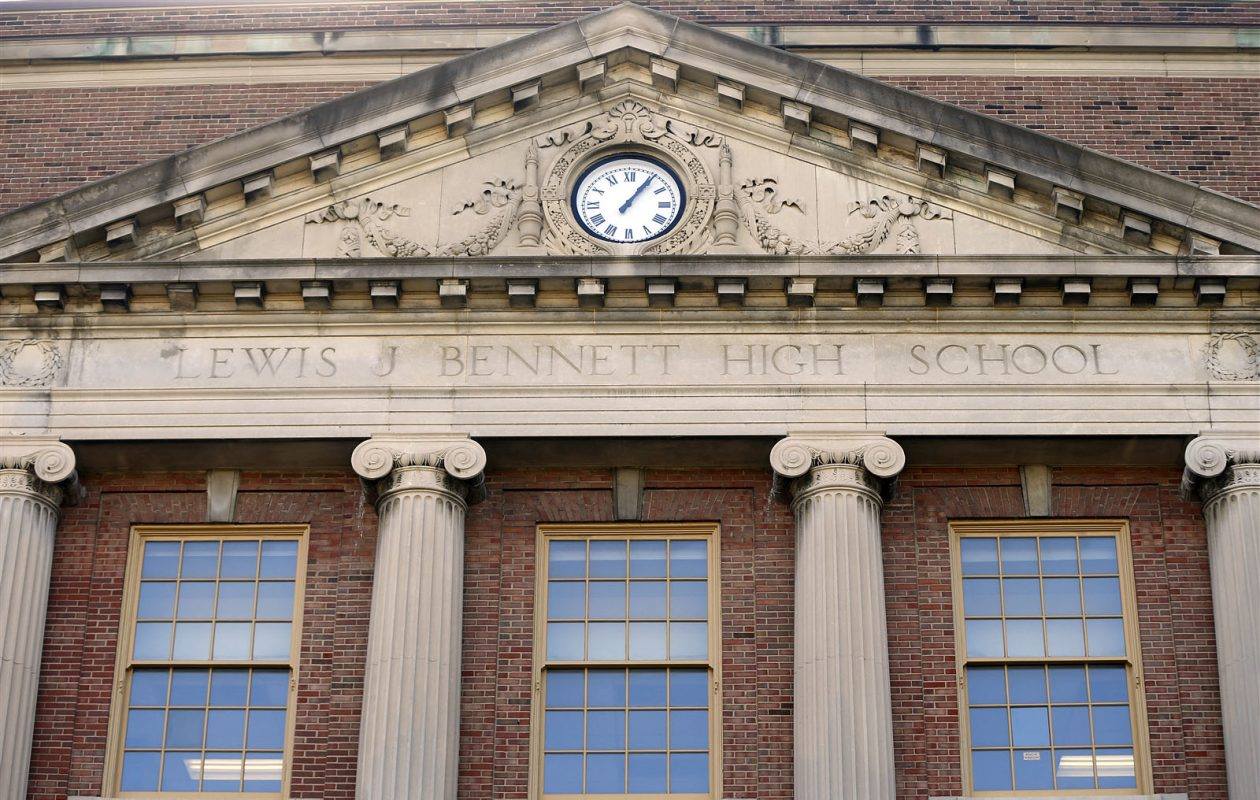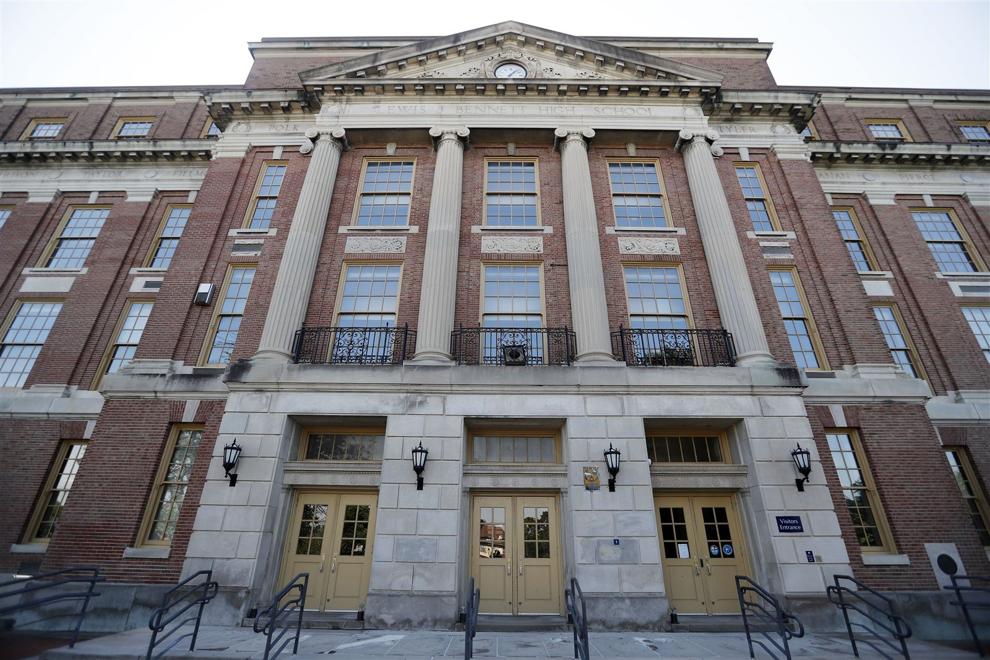
Lewis Jackson Bennett Image. (n.d.). History of Buffalo. Retrieved February 7, 2023, from https://www.buffaloah.com/h/ben/ben/index.html
Lewis Jackson Bennett was an entrepreneur …
Lewis Jackson Bennett who moved to Buffalo and founded a cement company. As his business grew, he needed to access more raw materials. The location he found to excavate the stone for his cement was on E. Amherst Street. The Amherst Street Quarry was used to exhaustion and has since been converted to McCarthy Park.
Beyond his business, Lewis J. Bennett wanted to build a community. He purchased acres of land which became and is still known as Central Park. The street boundaries are Hertel, Main, East Amherst, and Starin.
Main Street was a dividing line between Mr. Bennett’s cement company and the community he was developing. He was a shrewd businessman. Any home buyer wanting to build west of Main Street would use stone from the quarry east of Main St– both of which were purchased from Mr. Bennett.
Another mark left by this visionary was the naming of area streets. Woodbridge and Benwood are tributes to Mr. Bennett’s son-in-law, who died at an early age.
There was a threat to Mr. Bennett’s vision, however. There was talk of the railroad cutting right through his Central Park land. He had an idea. Give a large parcel of land on Main Street to the City to have the Board of Education build a school and eventually a stadium.
It was no surprise that there was a controversy between the City and the School District. The Mayor did not want to build a stadium. He thought that the parcel of land was too small. His alternate site was near Edward J. Meyer Memorial Hospital. Overcrowding at Hutchinson Technical and Lafayette made the need to accept the property more urgent than the Mayor’s objection. To tip the balance in favor of the Main Street site, the local businessmen’s association, The Mercer Club, lobbied and prevailed. The stage, then, was set for the building of a high school and the future All High Stadium. The Mercer Club would continue to support the school and its students until its dissolution close to the end of the 20th century.
With the land in place, a design had to be made. The Board of Education hired Buffalo Associate Architects of which E. B. Green was a partner. Ernest Cremi developed the design. The style of the building is Georgian Revival. It is modeled after London’s Buckingham Palace.
There were no drones in then, but there was an aerial design. So, from above, the building is shaped in the form of a huge capital B.
On the front of the building, Lewis J. Bennett’s name is prominently engraved just above the front doors. To either side and wrapping around the building is a ribbon of names of presidents of the United States up to 1925. It is clear the planners for this new school revered Mr. Bennett both by surrounding him with Presidents and, ultimately, naming the “school on the hill” for him.

Nussbaumer, [queenseyes]. (2018, February 6). Drone Image of Bennett Highschool. Buffalo Rising. Retrieved February 7, 2023, from https://www.buffalorising.com/2018/02/solar-success-in-nys/

As a sign of the times, the fourth floor was specifically designed to teach female students “Women’s Careers.” Included was a model apartment located in the center front of the fourth floor. The purpose was to teach home-making skills in a real setting. Sewing and hat making were course enhancements.
It takes a while to construct a school as big and complex as Bennett. Ground was broken on May 8, 1923. The rain was pouring down. Lewis J. Bennett had already suffered a stroke. His chauffeur brought him to the ceremony and literally held him up to turn the first spade of dirt. The work began, and Mr. Bennett retreated to his home in Florida. In April 1925, knowing he was near death, he returned to Buffalo to see the nearly completed school. He died three days after making his big effort to see his dream fulfilled.
While the building was being constructed, the first Bennett principal, Charles Elbert Rhodes was appointed. Mr. Rhodes worked closely on the new school from the time of the groundbreaking. He came with considerable experience in running a high school as he had been the Assistant Principal at Lafayette.
Principal Rhodes knew that he had to create a Bennett culture for the students and staff at the new school. He wanted there to be a sense of belonging for students and staff coming together for the first time. He personally wrote the Creed, the Handbook, and the Motto. He designated the school colors and chose the mascot, and he arranged for music teacher, Mr. Seibold, to compose the Alma Mater.
You have to be a close observer and very interested in history to notice the two plaques in the auditorium. Both were donated by Darwin Martin to inspire the thousands of students who would pass them. They are the “Offer of the College” and Lincoln’s Gettysburg Address.
The moment had come. It was September 1925. Two thousand two hundred students enrolled. New freshmen came and transfers from Hutch and Lafayette populated the upper grades. A solemn dedication was held on November 24, 1925. At the ceremony, Principal Rhodes introduced the symbols that he had developed and would become the traditional hallmarks that have unified students through the decades.


The population of Central Park was growing more rapidly than even the big school could handle. Five annex classrooms were placed behind the school with a capacity of 40 students each. Clearly, a more permanent solution had to be made. The plan was another new high school, Kensington, and the start of an intense rivalry between the two student bodies. It wasn’t until 1938 that Kensington finally opened.
Kensington joined with Bennett to set an attendance record for a high school football game. In 1948, 52,000 fans came to cheer. The Bennett stands grew quiet as the Tigers were defeated. The score may have been unfavorable, but the attendance record has become part of our shared history.
World War II came to the doorstep of Bennett and every other high school in the 1940s. The fun of growing up was interrupted by the seriousness of global conflict. Hundreds of students signed up to fight. They served in Europe. They served in the Pacific. They fought the Nazis. They fought the Japanese. Their names are proudly displayed in the front hall. Sadly, 78 died. They are memorialized by a plaque still hanging at the entrance.
On the home front, Bennett students sold War Bonds, enough to buy a Curtis airplane for the effort. It was an all-consuming endeavor embraced by every student and staff member to raise such a large amount of money. The reward was a Commando airplane with the Bennett Tiger symbol flying and joining the Allies in defeating the enemy.
During the 1940s the reputation of Bennett grew to national prominence. The scholarship of the faculty and the students was recognized. Evidence included a high level of learning that propelled graduates to prestigious colleges and universities throughout the country.
The philosophy of the school was that education went far beyond the rigors of the classroom. Education was about extra-curricular activities, and Bennett had far more than any other school. There were regular clubs like art, band, Student Council, Inter-High, science club, chess club, and camera club. Additionally, there were Hi-Y’s, the forerunners of the sororities and fraternities of the 1950s. There was roller skating, tapping, riding, drama, debate, stage crew, flag marshals and many, many more. There were 30 pages of clubs in the yearbook by 1957. Education wasn’t just for students but included the whole community who participated in much of what went on at the school. Bennett was the hub of Central Park.
The 1950s brought peace and stability and created an atmosphere of significant change and growth in the country. The Cold War prompted competition between the US and the Soviet Union. The Soviets launched spaceship Sputnik, and the Space Race was on. The curriculum changed too. The emphasis was now on math and science.
In the 1940s, teenagers danced to swing music. In the 1950s a radically new kind of music and dancing were the rage. This was the era of the birth of rock and roll. Bennett students were in the forefront by having huge dances at hotels and country clubs. They were the envy of high school students across the area. When they weren’t dancing, they were enjoying another new invention, the drive-in movie.
It is no surprise that students who lived in the suburbs or who lived in another area of Buffalo wanted to come to Bennett because of its academic reputation and its countless extra-curricular activities. It was “cool” to go to Bennett. Here’s how some of them enrolled. The magic words were “I want to take Hebrew” or “I want to take Russian.” Bennett was the only school offering these languages. An applicant could register by making this request.
In 1950, overgrown ivy was eating the mortar on the face of the building. The first significant reconstruction would take place. Besides the work on the exterior of the school, interior work included classroom remodeling and the conversion of the fourth floor from the model apartment to regular home economics, foreign language, and band classrooms.
Through the ’50s, the student population remained close to 2000. There were 91 faculty members. These numbers would soon be impacted by the landmark Supreme Court Decision, Brown vs. the Board of Education. This decision affected school districts across the country, and Buffalo was no different. Sweeping changes would follow.
The 1960s was a decade of enormous political and cultural unrest. Civil rights, hippies, drugs, and opposition to the “Establishment” were hallmarks of the time and indeed manifested themselves at Bennett. African American studies were part of the curriculum for our increasingly diverse population. Brotherhood Assemblies were held. Protests by students at our UB neighbor spilled over to our campus, forcing numerous lockdowns at our school. A political highlight of the time was a visit from Robert F. Kennedy, a U. S. attorney general, a NYS senator and soon-to-be candidate for President. Sadly, his candidacy cut short by an assassin in Los Angeles.
Not only were there big changes in society, but it was also time for the building to have major changes of its own. Safety issues were of primary concern as a massive plan for reconstruction unfolded. Locker banks on the first and second floors were removed and replaced with office spaces. The classroom transoms were sealed. Energy conservation was addressed by lowering the ceilings in every classroom.
The NAACP sued the Buffalo Board of Education over issues of segregation. In April 1976, Judge John Curtin found the District in violation and ordered that Buffalo schools be integrated. Superintendent Eugene Reville’s response was to establish three magnet schools and set the District on a course that would change education in Buffalo radically.
Before the Court Order, a progressive program was initiated at Bennett. It was an honors program for select students and faculty. It occupied the entire third floor of the school. It was started in 1975. This honors program, its curriculum, and staff were well received.
Faced with the judgment of the Court, in 1980 the mini honors program at Bennett was removed and expanded to its building, the vacated Fosdick-Masten High School, and was named City Honors High School. The removal of this talented component of Bennett negatively impacted the morale of those left behind.
The ensuing four years were not easy. Administrators and staff struggled to regain an identity and the reputation that Bennett had long enjoyed. Out of the stress of those years came new magnet programs introduced into the Bennett curriculum. There were magnets in Law, Computers, and International Studies. This was also a growth period in the identification of students with disabilities. Staffed with a quality core of experienced special education teachers, Bennett took on a new mission to help these young people earn high school diplomas and ensure hope for their futures.
Outside forces impacted the students and staff at Bennett. There was a city-wide teacher strike in September of 1976. Students were to report while their teachers walked the picket lines. The Taylor Law penalized the teachers who were fined two- day’s pay for every strike day. They sacrificed and won considerable concessions
from the Board of Education. All of this activity caused tension and anxiety for teachers, administrators, students, and their families.
With new programs established for magnets, Regents and special education, the 1980s were a time to return to Bennett’s high-standards and traditions.
The 1983-84 school year was one of inconsistency, and mixed messages as four different principals were assigned throughout the year. On August 22, 1984, Marilyn Wittman was appointed as the new principal at Bennett. Her mission was to establish order and out of that order to create an environment where students could once again reach high academic standards. Principal Wittman could not do this alone, however. She knew that she needed all the staff to work with her to meet these goals for students. She soon learned that the team was up to the challenge and worked at more than 100% to meet high Bennett expectations.
The halls were cleared, passes were mandatory, detention for tardiness was begun, cut slips were written for class skippers, and there were consistent consequences for breaking the rules. A dress code was strictly enforced, and measuring skirts above the knee was commonplace. Student and faculty handbooks made rules clear and consequences were set. There was no ambiguity, and all were responsible for complying.
With order restored, attention shifted to new ways of involving teachers in the work of curriculum and staff development. Department heads were created. For the first time, these teachers were given leadership responsibilities for curriculum, staff development, and student data. Down to the individual student, they knew what each needed to fulfill graduation requirements. They established a new focus on achievement to have all students earn a Regents diploma.
In addition to department heads, it was recognized that the magnet programs in law, computers and international studies needed designated faculty coordinators. The job of the coordinators was to recruit students to the magnet programs, to formalize the curriculum and to create small learning communities within the larger building. These students enjoyed close relationships among themselves and contributed their energies and talents to the whole student body.
The adjustment from 8th grade to 9th grade is a challenge to most youngsters. Coming from a small elementary school to a huge high school like Bennett was overwhelming to many both socially and academically. Together the administration and teachers worked to create a Freshman Flex Team, i.e., Freshman Learning Empowers Excellence. They employed what they learned about small learning communities in the magnets and applied that to 9th graders. Freshmen were block scheduled in teams, and teachers were scheduled for 9th graders only. Thus, another school within a school was established and proved highly effective in easing the transition.
Meanwhile, the State Education Department was setting new standards which included a Math A stand-alone exam to be passed as a graduation requirement. Had the department chairs not known each student and their academic needs individually, many would have fallen through the cracks and failed to graduate because of this one exam. Accommodations were made to help them meet the standards as there was no curriculum or class which they attended to prepare. Tutoring and Math A prep was offered to increase success. Even the community responded with tutors coming from the Central Park United Methodist Church.
Because of the attention paid to academics, Bennett was ready to go through the State Education Department’s Reregistration Process. Hundreds of individual records were created to document the data provided by the school. Months and months of preparation preceded the SED visit. To the delight of administrators and teachers alike, Bennett was deemed a school in good standing and retained its New York State registration.
With the sanction renewed, it was time to evolve to help our students in other ways. The staff recognized that our students have many challenges beyond the classroom. Sometimes the circumstances of their lives spilled over into traumatic experiences at school. It was up to the school to examine root causes and to create a process to help students solve problems that affect their work in school and to let them know that they are part of a community that cares.
The Quality School model was brought to the attention of administrators and teachers. They studied Dr. Glasser’s model to meet the basic needs of students and most of all, to create an atmosphere of belonging. One of the initiatives was development of the R & R room (the Resolution and Restitution Room). In the R & R room, dedicated staff was assigned to engage the students who were experiencing problems and to listen and make a plan to fix the issue with them. The school was served because a consequence was always designated if the student plan failed. The idea was to give the students a chance to reintegrate themselves into the school community and in the most serious cases to avoid suspension.
Complimenting the R & R staff was the MUST Team (Mobile Unit Supporting Teachers). The MUST Team was a district initiative which included a social worker, a psychologist, a special ed teacher, and a coordinator. The team worked with the most needy students and their parents and teachers. They were in charge of the big picture and accessed resources beyond the school to help students and their families.
With formal processes in place for academics and social needs, attention could be given to the things that make school fun. School activities once again abounded. A chronicle of these activities was recorded for 28 years by the yearbook staff and Mr. Neil Lange, aka “Mr. Bennett”, in the annual award-winning book, the Bennett Beacon.
Also formalized was leadership training. A leadership class was offered as part of the course offerings each year. The students enrolled were responsible for organizing and executing traditional and new activities. There were dances, movie-days, Easter egg hunts, Valentine cookies, the school store, fund-raising for community organizations, carnivals, and picnics. All of the services of the students were recognized at the annual Taste of Bennett, where at least 400 to 500 students were recognized for positive contributions to their school. Parents in large numbers came to the pre-ceremony dinner. The faculty served the dinner and then joined everyone in the auditorium where families cheered their children as they received an individual award.
Beginning with the school year 2004-2005, a series of new administrators were assigned to Bennett. The magnet programs were phased out, student attendance decreased alarmingly, and the reputation of the school declined rapidly. A series of initiatives were tried by various principals to turn the school around. In 2013, however, the New York State Education Department, citing low test scores and a declining graduation rate put Bennett High School on a list of schools to be closed. Sensing an opportunity to claim the building for a charter school, there were members of the Buffalo Board of Education who worked to give the school to Tapestry Charter. Bennett would no longer be a Buffalo Public School. The very existence of Bennett was threatened.
The Alumni Association reaction to the threat was quick. A meeting was set up with then-Superintendent Donald Ogilvie. He suggested two options. First, offer support to the Charter School in the hope of maintaining some sort of legacy at least with the building; or, second, write a plan for a whole new curriculum that would allow Bennett to remain a Buffalo Public School and continue its long traditions and restore its high standards.
This was not a hard decision for the Alumni Association. The Bennett Alumni Redesign Team was formed from members of the Alumni Association. Following a detailed outline from the Board of Education, the Redesign Team wrote a 156-page proposal for a new Bennett. The plan was comprehensive and well-received. There was one huge obstacle, however. The plan had to be approved by the Board of Education. The Board of Education had a majority who favored giving Bennett to Tapestry Charter School.
On February 13, 2014, the Board of Education vote was scheduled. When the vote was taken, the majority voted to close Bennett. Then the filibustering began. Members of the Board minority, wishing to keep Bennett as a Buffalo Public School, challenged the voting procedure for hours. During this time, Superintendent Ogilvie gradually introduced motions to save Bennett. Eventually, the majority relented, and Bennett was allowed to remain a public school. The Bennett Alumni Redesign Plan would be used as the blueprint for the new high school.
When Dr. Kriner Cash replaced Mr. Ogilvie as Superintendent, there was concern about his endorsement of our new school. With great relief, Dr. Cash totally embraced the new school and had suggestions of his own about making it a first-class, cutting edge program. Dr. Cash suggested that the school be named the Lewis J. Bennett High School of Innovative Technology. He showed his commitment to Bennett’s success by appointing an energetic, proven, forward thinking principal. Carlos Alvarez became the first principal of the new Bennett. He and the faculty and staff prepared for the first graduation which took place in June 2020.
What a graduation it was! It was like no other ever held at Bennett. It was outside on the field at All High Stadium. There was no audience. Graduates received their diplomas individually with only the administrators present. The moment was captured on video for each one. All of this happened because in 2020 the world was experiencing the COVID-19 Pandemic.
The Alumni Association and the Alumni Redesign team have remained active in the implementation of the Bennett plan. The group’s mission statement reflects its advocacy and support for the students personally, academically and financially. Working with the Board of Education, the Superintendent and the Principal, there is confidence that “The Best Is Yet To Be.”
